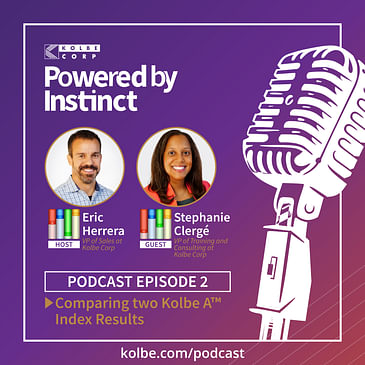Take the Kolbe A Index at Kolbe.com
The ideal work setting involves people getting along and working towards a shared goal. But not everyone approaches tasks the same way — even people in the same roles. Many businesses succeed because their management knows that diversity is vital. You don't want to form a team of look-alikes; you want different perspectives and personalities to drive your business growth.
It's often challenging, especially for employees, to collaborate with people who don't use the same work methods. But just because someone approaches a task differently than you doesn’t mean their approach is wrong. It probably just means they have a different working style.
In this episode of Powered by Instinct, Eric Herrera chats with Stephanie Clergé, the VP of Training and Consulting at Kolbe Corp. The two discuss the Kolbe Comparisons: A to A™ report and how it helps organizations understand their workforce and coworkers understand each other. This allows them to establish and compare each other's strengths and make the most out of them.
Eric and Stephanie use real-life examples to illustrate this. They compare their coworkers' Kolbe A™ indexes and explain why these individuals are in their particular role, what the result says about their strengths, and how they all — despite being more or less different — work with each other successfully.
Host: Eric Herrera (5392)
Guest-at-a-Glance
Name: Stephanie Clergé (8363)
What she does: Stephanie is the VP of Training and Consulting at Kolbe Corp.
Company: Kolbe Corp
Noteworthy: Stephanie works with Kolbe Certified™ Consultants — individuals who are trained to work with Kolbe solutions. ''What I love doing and get a chance to do every day is training for some of our clients. My goal is to make sure that folks using Kolbe have the information they need to do it well and apply it to whatever they care about the most.''
Where to find Stephanie: LinkedIn
Podcast Insights
🎙️ Kolbe Comparisons: A to A™ reports help identify potential conflict. The purpose of running a comparison report is to help us understand our and other people's strengths. It is particularly beneficial in the workplace, where people with different approaches to working have to collaborate. Therefore, the Comparisons: A to A report helps avoid conflict in a healthy and meaningful way and drives productivity in the office. ''A lot of times, people will try to solve these conflicts they have at work by doing some of the traditional stuff. But this isn't about not liking each other. It's just about two different ways of taking action.''
🎙️ Major differences ask for a different approach. Yes, some people can collaborate and bring good results even if they are different in every sense. But, unfortunately, sometimes that's not the case. ''Maybe these two shouldn't be working collaboratively. Maybe they need to work independently more often so that they don't drive each other completely crazy because there's only so much self-awareness and tips and whatever that can help. Sometimes you have to do things separately and then come together,'' says Stephanie.
If you would like to be a guest on Powered by Instinct or get in touch with any of our Kolbe Experts, send us a quick email: info@kolbe.com




